Wednesday, August 31, 2011
Three Dogs At Home: Picture That!
'via Blog this'
Three Dogs At Home: Design is in the Details
'via Blog this'
Use this idea for painting our brass fixtures.
Eye Exercises
Very interesting information for anyone whose eyesight is not perfectthese exercises strengthen the muscles around the eye.
- Rotation: Imagine a huge clock right in front of you, and slowly move your eyes from 12 to 1 to 2 and all the way around 5 times. Focus at each stop. Then do it 5 times in the opposite direction. Repeat 3 times a day.
- Alternating focus: Focus your eyes on something quite close, and then on something about 6 m (20 ft) away. Continue alternating your focus from close to far for about 5 minutes, and do this 3 or 4 times a day.
- Pencil pushups: Hold your finger or a pencil up at arm’s length and focus on it while slowly moving it to your nose. When the image doubles, move your finger back a bit and focus on it for a few seconds. You should do 10 repetitions 3 times a day until you can bring your finger to the tip of your nose without it appearing double.
- Relaxation: Rest your eyes regularly if you’re reading, working at the computer, or doing other close work. This means that every thirty minutes, you should take at least 30 seconds to focus on something distant. (A friend’s son was ordered to take a five-minute break every 20 minutes to save his eyesight. Same principle, I suppose.)
Tuesday, August 30, 2011
Thursday, August 25, 2011
Easy Grilled Vegetables

I could eat these easy grilled vegetables every day. And in the summer, we almost do. Sometimes it's just one type (green beans rise to new height done this way!) or a couple (zucchini and onion), but most of the time we grill a variety.
And you know that if I love something, you will be hearing about it sooner or later- so today I'm
We used to just grill slices of single vegetables - you know, slice the zucchini (or tomato, or onion...), carefully place them on the grill, and turn them with tongs until they were ready to eat. It usually took up a lot of room and was more work.
Then one day last summer we found a grill basket in the back of a cupboard that Brian's folks had given us and decided to grill up a few vegetables with it.
Oh. My. It was love - deep love - at the first bite. Why had this been sitting in our cupboard for so long? Who knows, and who cares, because this basket is in almost daily use during the grilling season.
After the vegetables are chopped (it's best to make them about the same size as you're able), just toss them with some olive oil, salt, pepper, LOTS of garlic, and some red pepper flakes for a bit of spiciness.
This is perfect for using up handfuls of veggies- either as they're ripening from the garden, or what you need to use up from the fridge. This time my bowl contained both- just a few mushrooms and a red pepper from the fridge plus onion, cauliflower, zucchini, green beans, carrots and potato from the garden.
I don't usually add potatoes, but I had just harvested some that I wanted to use up, and in order for these, the cauliflower, and the carrots to be done in the same amount of time as the other vegetables, I microwaved them with water to steam for a few minutes - just until they were crisp-tender. I sliced the potatoes pretty thin, but I should've pre-cooked them a bit more, because they still took longer than I wanted.

the best way to cook them is to start them over high heat for a few minutes without stirring. This seems to get some of the juices cooked out and starts the nice charring effect.

Then he stirs them around a bit, closes the lid and lets them cook over medium heat, stirring occasionally, for about 10 minutes until they are nicely browned and cooked through (though still crisp), with spots of wonderful, grilled-marked goodness.

- For an Asian flavor add some sesame oil and soy sauce instead of the olive and salt. And for spiciness, our favorite Sriracha sauce adds a nice bite.
- For a Middle-Eastern or Thai flavor try adding a teaspoon or so of curry powder and tossing them with a can of coconut milk after they're grilled and serve over rice.
- Purposely make extra to have enough to add to a pasta salad the next day.
Sunday, August 21, 2011
Cutting the Grid Apron Strings, One Appliance at a Time...
Our goal or focus as a family has been to 1) reduce our utility bills and 2) to become less dependent on utility companies in general. Living "off grid" meant either going with solar or wind power and producing our own energy. There really wasn't any other alternative in our minds.
But after reading a few blogs, conversing with Brenda of Freedom Acres Farm, and then reading Michael Bunker's book, Surviving Off Off-Grid, I've learned a lot over the last month and it's changed my mind a bit about our choices.
Going on solar power or wind power should only be seen as an intermediate step because you're only trading one dependency for another. This isn't to say you shouldn't use solar power, wind power, or some other alternative power source, but it isn't the grand solution to end all issues. Seeing solar as a way to ease into a life of less dependency is a more realistic option. And before one can even consider an alternative power source, you've got to cut back on your current dependency. Brenda really helped me see the need for this (thanks, Brenda!).
Now if I were to suddenly go through my house and trash every electrical appliance or gadget, I'd certainly have a mutiny on my hands, quick as a wink! And I won't attempt to list all our energy dependent appliances, but what I'm trying to do is cut the apron strings to the grid one appliance at a time. Let me give you an example...
This has been our coffee pot for the last several years. It's usually used on a daily basis, heating the coffee for about 2 hours before the hot plate shuts off unless we think about it and turn it off manually (not often). We like it a lot except that it stopped working the other day despite my regular cleanings and maintenance. Normally, we would have immediately gone out and purchased something similar, but this time, I talked with my husband about considering alternatives.
One option that we already had in the back of a cabinet is a French Press. I purchased this a couple of years ago when we were traveling, attending a retreat, and I needed my own low-acid coffee. It's a straightforward alternative in which you place the grounds inside the bottom, pour boiling water over them, stir, let steep for a minute, and then gently press the plunger down over the grounds. You can then pour your coffee. The French Press is easy to clean and simple to operate.
The drawback to the French Press is that it can't go directly onto a heat source (at least mine can't), the glass could easily break, and it doesn't keep the coffee hot. Think of this as an immediate coffee maker in which the coffee should be consumed as soon as it's brewed. Mine will make about 3-4 regular cups, so it's fine if you have a small group. However, if you want another cup, you'd need to start over.
A second alternative was an old fashion percolator; my husband's preference. We purchased this stainless steel model at an army surplus store before our camping trip to the coast. Another uncomplicated device, which holds coffee grounds in a basket containing small holes, while pumping heated water up a tube into the basket, allowing the water to wash over the grounds and then drain through the holes back into the pot. The cycle repeats itself until it's brewed to your preference. Since the holes in the basket are small, large grounds don't come through, but smaller grounds do. Some opt to use a paper filter inside the basket to prevent this.
Now you might be thinking that this little change isn't much and so why bother? What's the difference in a little ol' coffee pot? It's a small change indeed. But little things add up over time. Imagine changing 12 of your appliances over the course of a year? One per month? That would start to make an impact, now wouldn't it. Maybe not in terms of the world, but in your own immediate world, it certainly would! And if you're considering solar power, you're more than likely going to need to reduce your electrical usage if you want to go off grid anyway.
If we were to install solar realistically (and believe me, we've looked into it with 3 different companies), we could only generate 60% of what we are currently using. We'd still need to purchase the additional 40% of electricity - ON A GOOD DAY! That means, to be totally off-grid, we'd need to reduce our energy consumption by 40-50% before the solar was ever installed. Puts things into perspective a bit more, doesn't it?
 |
| Ryobi Power Usage Meter |
Obviously, each person will have that one appliance they just don't want to give up and they'd rather pay to use it. This is exactly why we should be allowed to govern our own lives and not have the government tell us what we can and cannot use. What's important to me, may not be important to you and visa versa. But it's good to know there are alternatives, what they are, how to use them, and if possible, obtain them as a back up. Just in case.
Wednesday, August 17, 2011
Give Away: Back Yard Food Production!
• An overview of how she began her journey and her homestead's situation in terms of climate and soil
• Watering solutions - sources, harvesting, and containment
• Gardening - how she raises enough to feed her family, and I mean all of it!
• Rabbits as a sustainable protein source
• Home butchering (rabbits are done in detail and then a couple of other small animals are addressed as well)
• Poultry as another sustainable protein source (more for eggs than meat, but she does discuss meat)
• Dogs as a working animal on your homestead
• Perennials: Orchards, Food Forests, and Edible Landscaping (Permaculture)
• Other Essentials: everything from solar food dehydration to hog panels!
It really was helpful having Marjory share what didn'twork for her, and I was encouraged by the fact that she didn't do this overnight. She's very clear that every homesteader should start small and learn from each step before jumping into something bigger. Honestly, I've wondered at times if being a sustainable homesteader was really possible in this day and age, but seeing what she's done on a small acreage with just a couple of hours each day to maintain what she's established has given me a renewed vision that it CAN happen.
During the video, Marjory will often reference a document that she's included on a separate CD for you to access. This is like getting a book of all the important, need-to-know information along with the DVD - primary sources! Some are from her state of Texas, but don't be mislead to think they won't help you. I spent some time going over the Texas Rainwater Harvesting document and it's an excellent 88 page resource for anyone, anywhere. It includes color pictures of examples along with detailed instructions for setting up your own system. All you'd need to do is find out your own state laws in order to be compliant locally.
Friday, August 12, 2011
Monday, August 8, 2011
Kids Bathroom Makeover—Installing Board and Batten
Don’t you love it? I looked for a shower curtain high and low and everywhere in between! I was beginning to think that the perfect shower curtain just didn’t exist. And then I found this baby. (And just as a side note—it was $21.99 but it came with a small flaw in the fabric and so I called them and they knocked $10 off the price—so I only paid $11.99 for my PERFECT shower curtain!!—and you can’t even see the flaw—can you?)
Then we decided to add some fun and interest to the walls of the bathroom. I had found these instructions from one of my favorite blogs (320 Sycamore) for an inexpensive way to do board and batten and knew this would be perfect for this room.
So we purchased a bundle of inexpensive Lath pieces from Home Depot. My hubby sanded them down and we installed them about 10” apart.
Next we added a 1 x 4 piece of primed MDF for the top.
Then my hubby filled all the holes and sanded them all down.
Next it was up to me to caulk all the edges and paint it up. This was the time consuming part. But I think it turned out awesome!
Next we added some handy little towel hooks and put up my FAVORITE bathroom art: pictures of MY BABIES.








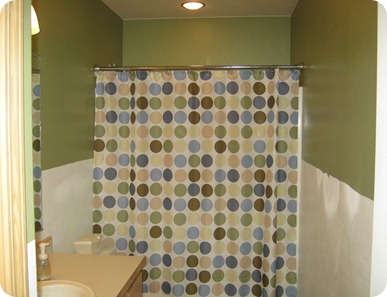
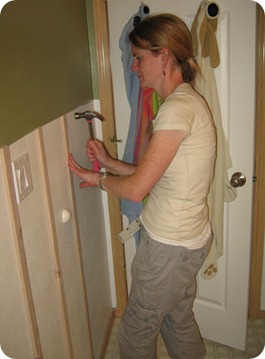
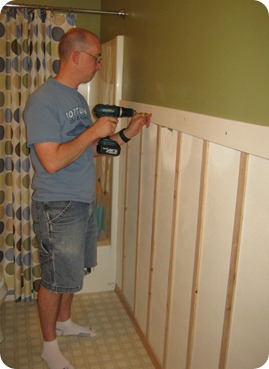

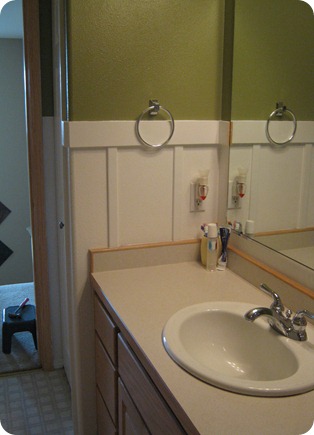
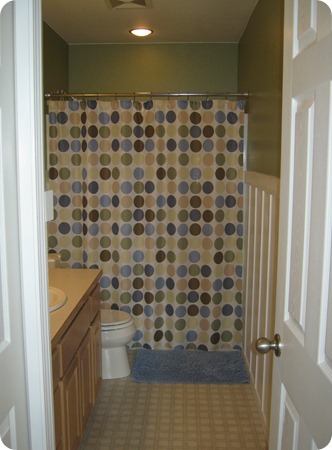
![IMG_1841[1] IMG_1841[1]](http://lh5.ggpht.com/-7wZUEz6K16s/TjDug5R5YQI/AAAAAAAACM0/nZIpObKkhcM/IMG_1841%25255B1%25255D_thumb%25255B2%25255D.jpg?imgmax=800)
![IMG_1842[1] IMG_1842[1]](http://lh3.ggpht.com/-xc7AzMdgqNo/TjDuhllAiFI/AAAAAAAACM8/xl7deB24y6s/IMG_1842%25255B1%25255D_thumb%25255B3%25255D.jpg?imgmax=800)
![IMG_1843[1] IMG_1843[1]](http://lh6.ggpht.com/-SaId-WPgyMg/TjDuiZ18pRI/AAAAAAAACNE/Fhdrbk5Fcz0/IMG_1843%25255B1%25255D_thumb%25255B3%25255D.jpg?imgmax=800)